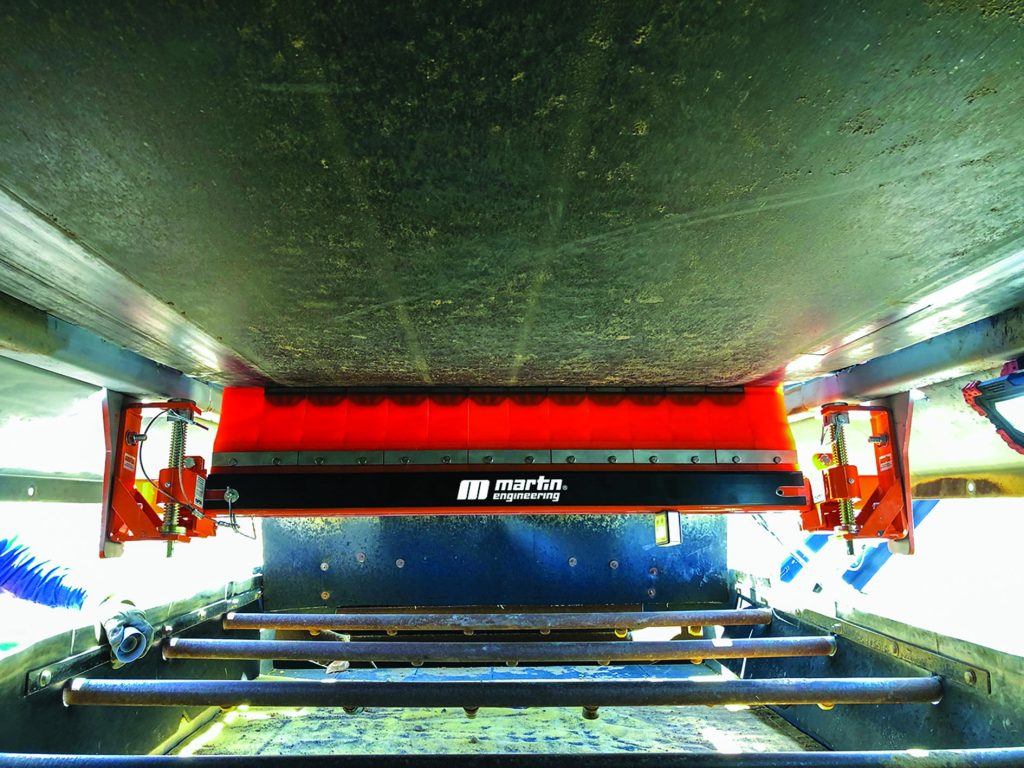Martin Engineering
There are many issues to consider when specifying the most asymmetrical blade wear. appropriate conveyor belt cleaner, not the least of which is maintaining proper tension to achieve optimum cleaning performance without introducing related problems. Inadequate tensioning causes carryback to cling to the belt and spill along its path, piling up under the conveyor and emitting excessive dust. This requires extra labor for cleanup and can affect air quality. Over-tensioning leads to friction damage to the carrying side of the belt, premature blade wear and potential splice damage. Both scenarios contribute to unsafe work conditions and raise the cost of operation.
“There are two basic approaches to applying tension to the belt cleaner: linear and rotary,” Mueller continued. “The blade’s cleaning position and angle of approach to the belt often dictate whether a linear or rotary tensioner is used.”
The Conveyor Equipment Manufacturers Association (CEMA) defines the cleaning positions as primary, secondary, or tertiary. Primary cleaners typically function with a “peeling” action, while secondary and tertiary cleaners are usually scrapers. Belt cleaners mounted in the primary position generally employ a rotary style tensioner, while most units mounted in the secondary or tertiary positions use linear style tensioners.
In most cases, belt tensioners have to be monitored and adjusted manually so they can maintain optimum pressure and carryback removal. Estimating when blades need changing is often a guessing game that, if left too long, could lead to unnecessary complications.

Linear Tensioner on Secondary Cleaner
Linear Tensioners
“Linear tensioners are most often applied where the compensation for wear is required in small increments, such as with hard metaltipped cleaners located in the secondary cleaning position or with brush cleaners,” Mueller said.
The simple design of linear tensioners often allows just one setting for full blade wear. Further, these tensioners can accommodate actuator deflection for accurate adjustment of cleaning pressure, delivering the ability to accommodate uneven mounting positions or asymmetrical blade wear.
Rotary TwistTM Tensioner on Primary Cleaner
Rotary Tensioners
The required tensioning forces can be applied by springs, hydraulic or pneumatic cylinders, electric actuators or from torque stored in an elastomeric element. Rotary tensioners are often used with urethane blades, where the change in blade height and thickness as it wears is significant. Rotary designs tend to be compact and, in most cases, the actuator(s) can be mounted at any orientation, which provides options for installing the belt cleaner in the optimum position.
N2® TwistTM Tensioner
Air Tensioners
Air tensioners use the resilience of a pneumatic cylinder to cushion impact. The tensioners can use Martin’s Air Connection Kit to plug them directly into an existing air system, allowing for a more streamlined installation process.
N2® Position Indicator On Spring Tensioner
Auto Tensioner/Position Indicator
Martin Engineering’s smart technology platform includes the company’s patented N2® Position Indicator to monitor primary cleaner blade wear and inform operators when the blade needs changing. The system uses a cellular gateway that relays data to the cloud and then to the user, delivering actionable information in real time.
The N2 PI and Smart Device Manager App ease the burden on managers and workers so they can focus their attention on other critical details of the operation. Precise tensioning and improved belt cleaning reduce the volume of dust and spillage from carryback, improving workplace conditions and decreasing the labor needed to maintain and clean around the discharge zone.
Safety of personnel and the belt itself is the primary consideration when selecting a tensioner. Ease of inspection and maintenance is critical for belt cleaner effectiveness, so the tensioner must allow quick and safe service. Martin Engineering offers the services and tensioning products that are necessary to meet the multifaceted demands of belt cleaning.